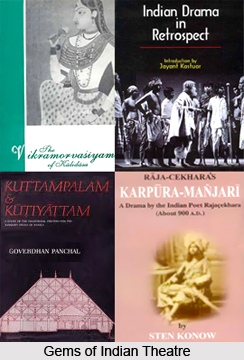 Dialogue plays a pivotal role in Indian theatre. Ancient dramatists gave great importance to dialogues and appropriate dramatic delivery. According to the Natyashastra, the choice of words in a play is of great importance and it is the body of the dramatic art. Vacikabhinaya or verbal representation mainly comprises proper pronunciation, modulation, intonation and rhythm. Use of dissimilar dialects and accurate forms of address to persons according to their ranks or social status are also included. These rules are highly structured and are well modified to bring out the lyrical and expressive qualities of a play.
Dialogue plays a pivotal role in Indian theatre. Ancient dramatists gave great importance to dialogues and appropriate dramatic delivery. According to the Natyashastra, the choice of words in a play is of great importance and it is the body of the dramatic art. Vacikabhinaya or verbal representation mainly comprises proper pronunciation, modulation, intonation and rhythm. Use of dissimilar dialects and accurate forms of address to persons according to their ranks or social status are also included. These rules are highly structured and are well modified to bring out the lyrical and expressive qualities of a play.
Instructive or entertaining dialogues are of great significance in Indian theatre. Even the religious scriptures of India like the Vedas, the Upanishads, the Samhitas, the Mahabharata, the Tantras, the Puranas, and the Jataka are in the form of conversations. The other name of Veda is sruti, because earlier it was heard in conversation. The Natyashastra insists on substantial dialogue and prescribes that the words employed in dramas should be evocative, deep in implication, approved of by Vedas and acceptable to all persons. For instance, the dialogue between Atreyi and Vasanti in the Uttararamacarita, between Sagarika andSusangata in the Ratnavali, beyween Kasyapa and Shakuntala in the Abhijnanasakuntalam, between Bhimasena and Draupadi in the Venisamhara, between Urvashi and Pururavas in the Vikramorvastya, between Canakya and Candanadasa in the Mudraraksasha are vigorous and deep in meaning.
The language of Bhasa is very lucid, natural and touching, alternating with simple figures of speech. The language of Kalidasa is remarkably easy. Bhavabhuti in the Uttararamacarita uses somewhat more difficult language. In his other two plays, and especially in the Malatimadhava, it is more elaborate and difficult. The Mricchakatika presents fewer difficulties than any of these dramas. Ordinary dialogues in Sanskrit plays are for the greater part in prose, but reflections or descriptions and poetical fancy take the form of verse. Intonation or kaku refers to the change of voice under different emotions such as fear, anger, and anguish.
Dhvanervikarah, connoting variations or modulation of sound in the intonation, can be considered to be the generic definition of kaku. The word kaku is applicable to both dramaturgical and musical literature. The Natyashastra by Bharata gives the detailed dramatic aspect of kaku and its musical aspect is given by the Sangitaratnakara.
Intonation or Kaku is a word of negation which is used in a manner implying the affirmative, as in question of appeal. Slow or vilambita intonation is desired in the comic, the erotic and in the pathetic sentiments. The excited or dipta and high or ucca intonations are applicable in the heroic, the furious and the marvellous sentiments. Fast or druta and low or nica intonations have been prescribed in the terrible and the repulsive sentiments. Thus intonation is largely dependent on the bhava and rasa. Dialogues serve the purpose of enhancing the beauty of presentation of plays.




